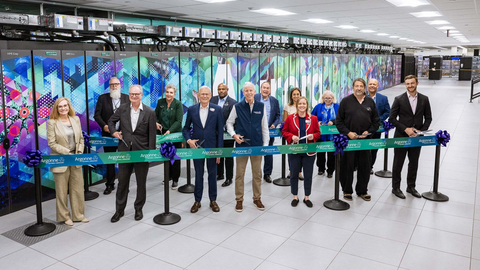The U.S. Department of Energy’s (DOE) Argonne National Laboratory hosted a ribbon-cutting ceremony to celebrate its new Aurora exascale computer, marking a major milestone for AI-powered science. The event brought together DOE leaders, researchers, and partners from Intel and HPE to recognize Aurora’s potential to transform scientific discovery.
This press release features multimedia. View the full release here: https://www.businesswire.com/news/home/20250716533510/en/

Secretary of Energy Chris Wright and leaders from Argonne, Intel and HPE cut the ribbon to celebrate the Aurora exascale supercomputer. (Image by Argonne National Laboratory).
“Aurora is a powerful example of what American science and innovation can deliver,” said U.S. Secretary of Energy Chris Wright. “As global competition accelerates, systems like Aurora give the United States a decisive edge in artificial intelligence, scientific discovery, and national security — fields where we can’t afford to fall behind. We’re at the start of a new Manhattan Project. If we don’t unleash American energy, innovation, and American science, we will lose Manhattan Project 2 — with President Trump’s leadership, the United States will win the AI race, but it will take energy dominance and strong public-private partnerships like the one behind Aurora to win this critical race.”
Deployed for science earlier this year, Aurora is one of the most powerful computing systems ever built. The machine is designed to accelerate breakthroughs in science and engineering by combining simulation, AI, and data analysis capabilities at an unprecedented scale.
Aurora is one of three DOE supercomputers to surpass the exascale threshold, capable of performing more than a quintillion calculations per second and is one of the world’s fastest supercomputers for AI performance.
Developed in collaboration with Intel and HPE, Aurora is equipped with 63,744 graphics processing units (GPUs), making it one of the largest GPU-powered supercomputers in the world. Spanning eight rows of refrigerator-sized cabinets and covering 10,000 square feet, Aurora features advanced water-cooling infrastructure and over 300 miles of networking cables.
Aurora is already enabling breakthroughs across a wide range of scientific fields. In biology and medicine, researchers are using AI and simulation to predict virus evolution, improve cancer treatments, and map neural connections in the brain. In aerospace engineering, Aurora is helping scientists better understand airflow around aircraft, reducing the need for physical testing and accelerating the design of quieter, more efficient planes.
Aurora is advancing fusion energy research by simulating extreme reactor conditions and using AI to predict particle behavior. In quantum computing, Aurora supports large-scale simulations to validate quantum experiments and test algorithms for molecular design.
By delivering faster, more accurate insights across research fields, Aurora is powering a new era of science driven by AI, simulation, and collaboration, with far-reaching impacts on technology and everyday life.
View source version on businesswire.com: https://www.businesswire.com/news/home/20250716533510/en/
Contacts
Christopher J. Kramer
Head of Media Relations
Argonne National Laboratory
Office: 630.252.5580
Email: media@anl.gov







